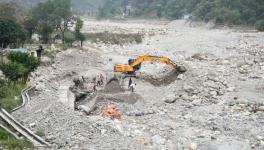Indian Ocean Warming may Cause India’s Wind Energy Generation to Suffer
Image Courtesy: Techxplore
Warming of the Indian Ocean may prove to be a setback for the ambitious target of generating 60 GW (giga watt) of wind capacity by 2022 that India has undertaken. The project would cost India dearly—crores of money has been invested on it.
A new study from the Harvard John A. Paulson School of Engineering and Applied Sciences (SEAS), US and the Harvard China project finds that the warming Indian Ocean may cause a slow decline in India’s wind power potential. The research paper is published in Science magazine, dated December 5.
India happens to be the third largest carbon emitter after United States and China. As an alternate source of power, apart from hydro and fossil sources, India has set the goal of tapping the potential of the enormous wind that the country receives—especially during summer monsoons and also otherwise. The majority of the wind turbines are, as of now, built on the Southern and Western part of the country. This is done with the aim to best capture the winds of summer Indian monsoon. It needs to be mentioned here that India is a signatory of the Paris Agreement 2015 which aims to limit temperature increase between 1.5 0 C to 2.0 0C by 2030, and the latest UN emission gap report hints towards inadequacy of commitments made by the countries.
Also Read: More Commitments Needed to Tackle Climate Change, Warns UN Report
The South-west monsoon in India starts in mid-summer in June when it first hits Kerala. The monsoon also brings huge energy in the form of wind.
But global warming has caused Indian Ocean water to become warmer. These warming waters have troubled the monsoon and caused it to weaken, resulting in a steady decline in the wind generated power.
Meng Gao, the first author of the study and also a post-doctoral fellow at SEAS says, “We found that although India is investing heavily in wind power to tackle climate change and air pollution issues, the benefits of these substantial investments are vulnerable to the changing climate”.
The research takes into account the hourly wind data for the period 1980-2016 from a meteorology reanalysis dataset. They found that the wind power potential has declined over this interval, particularly in the Western parts of India. Over 63% of India’s annual energy production from wind energy comes from monsoon winds of summer and spring. But for the period of four decades that the study analyses, the energy potential has witnessed a sharp decline of almost 13%.
The surface temperature data also confirmed that significant warming of the Indian Ocean also occurred over this period of time and as a result modulation of high pressure over the ocean has also taken place. Numerical calculations in the study showed that warming of the Indian Ocean contributed to the subsidence and dampening of upward motion of wind over the Indian continent resulting in weakening of the circulation and speeds of the monsoon winds.
Also Read: Can Indian Ocean’s Role in Last Ice Age Determine Future Climate Change?
Western states of India, particularly Rajasthan and Maharashtra, have seen the steepest decline in wind energy over the four decades. These are also the states where investment in wind power is the highest. Contrarily, Eastern India witnessed smaller or no decline over that period.
These findings are also suggestive of where to invest more on building the wind turbines in order to avoid the ills of climate change and get the optimal benefits of wind energy as an alternate energy source.
As a next step, the researchers plan to explore the future of India’s wind power with the help of projections from climate models.
Get the latest reports & analysis with people's perspective on Protests, movements & deep analytical videos, discussions of the current affairs in your Telegram app. Subscribe to NewsClick's Telegram channel & get Real-Time updates on stories, as they get published on our website.
























